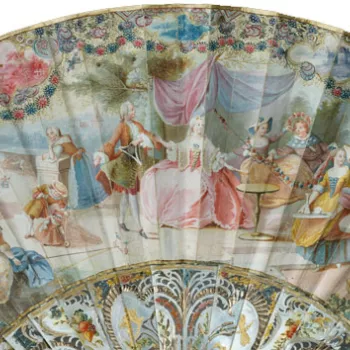Humming-bird fan c. 1870
Circular handscreen of white feathers (turkey or chicken) sewn onto a gauze base; in the centre a Brazilian Ruby humming bird (Clytolaema rubricauda); handle of turned bone | 33.0 cm (guardstick) | RCIN 25415

-
This ‘novelty’ fan is of a type produced in large numbers in Brazil in the 1870s. Although it has a traditional association with Canada (and specifically with Niagara), it must have been manufactured in Brazil, where humming-birds are indigenous.
The Princess of Wales was photographed holding this fan in 1871, when dressed for the Waverley Ball held at Willis’s Rooms in King Street, St James’s (London), to commemorate the centenary of the birth of Sir Walter Scott and to raise funds for the completion of the Scott Memorial in Edinburgh. The guests at the ball dressed as different characters in Scott’s novels. The Princess of Wales was dressed as Mary, Queen of Scots, and the Prince of Wales as the Lord of the Isles. A number of the other guests (including Mrs Charles Forbes and the Countess of Shrewsbury) were also photographed holding these somewhat incongruous feather fans.
An explanation may be found in the presence of Pedro II, Emperor of Brazil, in England at the time of the Waverley Ball, and the Emperor’s fondness for Scott’s works. After the Emperor’s visit to Windsor on 5 July 1871, Queen Victoria noted in her diary: ‘He means to visit Scotland on account of Walter Scott whom he so much admires.’ Links between the British royal family and Brazil were also maintained through the sister of Pedro II, who was married to the Prince de Joinville, third son of King Louis-Philippe.
Text adapted from Unfolding Pictures: Fans in the Royal Collection, 2005Provenance
In possession of Alexandra, Princess of Wales (later Queen Alexandra) by 1871, when she wore it as part of her Mary Queen of Scots costume to the Waverley Ball.
It has been suggested that this may have been a gift from the Emperor of Brazil, Pedro II, who was visiting England and met with Alexandra, Princess of Wales on the eve of the ball, when it is possible he may have given this fan as a gift. See Maria Crinstina Volpi, 'The Exotic West: The Circuit of Carioca Featherwork in the Nineteenth Century', Fashion Theory, The Journal of Dress, Body and Culture, 2016. -
Creator(s)
(fan maker)Acquirer(s)
-
Medium and techniques
Circular handscreen of white feathers (turkey or chicken) sewn onto a gauze base; in the centre a Brazilian Ruby humming bird (Clytolaema rubricauda); handle of turned bone
Measurements
33.0 cm (guardstick)
Place of Production
Brazil








